 Despite being judged the fourth most digitally-savvy nation in Europe, it seems that 40% of the UK adult population don’t know their wi-fi from their waffles.
Despite being judged the fourth most digitally-savvy nation in Europe, it seems that 40% of the UK adult population don’t know their wi-fi from their waffles.
Research carried out by Freedom2Surf revealed that half of all women and one quarter of all men didn’t have the slightest clue what WiFi was, exposing a very strong gender, knowledge and awareness gap in the UK.
Not surprisingly, the kids were waaay down with that WiFi thang, with Freedom2Surf’s WiFi Report revealing that the 16-24yr old age group were well hip to the technology, with almost 30% connecting to the Internet via a WiFi hotspot more than once a week.
Looking at the amount of time people spent connected via WiFi, the report found that 40% of regular users spend 10 minutes a day on average connected to a hotspot, while a further 40% spend at least an hour in a single session.
Around 10 per cent of users surveyed connect three to four times a day for at least 20 minutes at a time.
The research discovered that WiFi usage is set to increase, with over a third (35%) saying that they expected to spend more time wirelessly connected in the coming year.
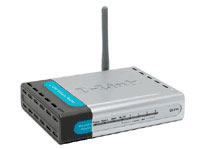 A smaller group (15%) expected their usage to increase dramatically in 2005, with the 16-24yr age group expected to increase its usage the most (52%) compared to 34 per cent of the 35-44 age group.
A smaller group (15%) expected their usage to increase dramatically in 2005, with the 16-24yr age group expected to increase its usage the most (52%) compared to 34 per cent of the 35-44 age group.
The biggest barrier preventing UK consumers connecting to hotspots was found to be the lack of regular access to a Wi-Fi enabled laptop (40%).
Cost was also perceived as a major factor, with 30% citing price as the biggest barrier.
Greater uptake has also been hampered by consumers expressing bafflement as to where hotspots are actually located along with the perceived complexity of set-up and payment for WiFi hotspot services.
Silver surfers (UK consumers aged 55+) were revealed as being the weakest Wi-Fi user group, with just 11 per cent of the old ‘uns having used a hotspot.
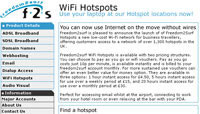 Geographically, London takes the honours as the King WiFi hotspot of the UK with a higher awareness and usage of WiFi (hardly surprising since there are more hotspots in London than anywhere else in the UK) whilst residents oop North in Yorkshire are the least Wi-Fi savvy.
Geographically, London takes the honours as the King WiFi hotspot of the UK with a higher awareness and usage of WiFi (hardly surprising since there are more hotspots in London than anywhere else in the UK) whilst residents oop North in Yorkshire are the least Wi-Fi savvy.
Naturally, ISPs like Freedom2Surf don’t do surveys out of the goodness of their hearts, and predictably rounded off their report with a ten-ton size plug for their new low-cost Wi-Fi service, Freedom2Surf Hotspots.
The company will be partnering with BT Openzone to offer customers access to a network of 1,300 hotspots in the UK, with rates claimed to be “up to 50% lower than those offered by BT.”
These prices work out at 10p (€0.14/US$0.18) per minute (occasional use), £4.50 (€6.60/US$8.5)for a daily voucher (60 Minutes), £15 (€22/US$28) for a weekly voucher (5 hours) and £30 (€44/US$56) for a monthly voucher (20 hours). Payment can be bought on a Pay as You Go basis by purchasing vouchers with a credit card.
Compared to our American counterparts, these prices still seem outrageously steep to us, but Chris Panayis, managing director of Freedom2Surf, clearly doesn’t agree: “The use of WiFi hotspots is becoming increasingly mainstream particularly among the younger age group, and it is encouraging that many of the consumers we surveyed are planning to significantly increase their use of WiFi this year.
“With service providers like Freedom2Surf already acting to reduce the cost and complexity of connecting to WiFi hotspots, the next challenge for the industry is to boost awareness of where hotspots are located and continue to educate consumers on the flexibility that WiFi hotspots provide people who need to connect to the Internet on the move.”
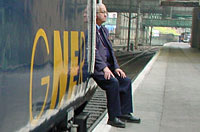 A UK train operator has claimed that its passengers will be able to wirelessly access the Internet on all its trains by May 2007 after widespread passenger take-up of the service.
A UK train operator has claimed that its passengers will be able to wirelessly access the Internet on all its trains by May 2007 after widespread passenger take-up of the service. GNER’s chief operating officer Jonathan Metcalfe enthused about onboard Wi-Fi, claiming that it would make the travelling experience “more enjoyable” for consumers and that it would “encourage more people to choose rail instead of driving or flying.”
GNER’s chief operating officer Jonathan Metcalfe enthused about onboard Wi-Fi, claiming that it would make the travelling experience “more enjoyable” for consumers and that it would “encourage more people to choose rail instead of driving or flying.”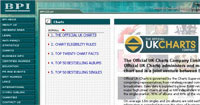 In a never-ending quest to stem the flow of illegal file sharing, the UK record companies’ trade association, the BPI (British Phonographic Industry), has announced that is taking legal action against another 33 illegal filesharers in the UK.
In a never-ending quest to stem the flow of illegal file sharing, the UK record companies’ trade association, the BPI (British Phonographic Industry), has announced that is taking legal action against another 33 illegal filesharers in the UK. The BPI ramped up the pressure on March 4 this year, declaring that it intended to pursue proceedings against 31 more illegal filesharers. The offenders were sent details of the BPI’s legal claims against them yesterday after their identities were revealed by their Internet service providers.
The BPI ramped up the pressure on March 4 this year, declaring that it intended to pursue proceedings against 31 more illegal filesharers. The offenders were sent details of the BPI’s legal claims against them yesterday after their identities were revealed by their Internet service providers.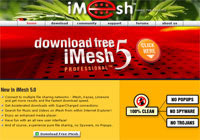 All of the accused are alleged to have been indulging in an orgy of uploading involving hundreds or thousands of music files illegally and face civil action for an injunction and damages.
All of the accused are alleged to have been indulging in an orgy of uploading involving hundreds or thousands of music files illegally and face civil action for an injunction and damages. UK Online is hoping to bring broadband to the masses by smashing the price point for “entry-level” home broadband down to a wallet-untroubling £10 a month.
UK Online is hoping to bring broadband to the masses by smashing the price point for “entry-level” home broadband down to a wallet-untroubling £10 a month. Surfers not used to this level of generosity may be wondering where the catch is, but we haven’t found it yet: we wrote to UK Online and they confirmed that both the Broadband 500 and Broadband 2000 are unlimited services with the Broadband 8000 offering an enormous 500GB monthly download allowance.
Surfers not used to this level of generosity may be wondering where the catch is, but we haven’t found it yet: we wrote to UK Online and they confirmed that both the Broadband 500 and Broadband 2000 are unlimited services with the Broadband 8000 offering an enormous 500GB monthly download allowance. We’ve never quite been persuaded to move to 3, but these two price plans they’ve just announced sure look tempting.
We’ve never quite been persuaded to move to 3, but these two price plans they’ve just announced sure look tempting.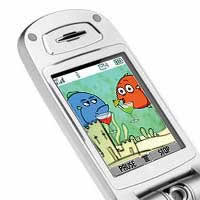 The second plan, “Talk, Text & Video 600”, is an enhancement to 3’s best selling plan, “Talk & Text 600”.As you’ve probably worked out, clever reader, this new plan bundles in 3’s video mobile services to the £35 (US$65/€50) a month package.
The second plan, “Talk, Text & Video 600”, is an enhancement to 3’s best selling plan, “Talk & Text 600”.As you’ve probably worked out, clever reader, this new plan bundles in 3’s video mobile services to the £35 (US$65/€50) a month package. Bob Fuller, 3 UK CEO swivelled on his heels and span out the corporate spin: “3 is the fastest growing network in the UK, we now have over 3 million 3G customers and we continue to lead the market for both value and video mobile services. With these new price plans 3 continues to set the pace for value in the UK mobile market. 3 was the first network to launch live, over-the-air, multi-player gaming, the first to stream concerts live over video mobile and first to launch quickplay video streaming of 3’s content.”
Bob Fuller, 3 UK CEO swivelled on his heels and span out the corporate spin: “3 is the fastest growing network in the UK, we now have over 3 million 3G customers and we continue to lead the market for both value and video mobile services. With these new price plans 3 continues to set the pace for value in the UK mobile market. 3 was the first network to launch live, over-the-air, multi-player gaming, the first to stream concerts live over video mobile and first to launch quickplay video streaming of 3’s content.” Irish VoIP solutions provider Cicero Networks has announced its first major telecom provider deal with Talktelecom Ltd, an independent, fully licensed General Telco Operator, based in Dublin.
Irish VoIP solutions provider Cicero Networks has announced its first major telecom provider deal with Talktelecom Ltd, an independent, fully licensed General Telco Operator, based in Dublin.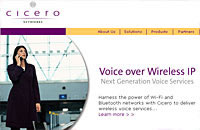 “Cicero Networks’ integrated end-to-end solution has given us a fast time-to-market in delivering a truly innovative and cost-effective wireless voice service,” buzzworded Talktelecom CEO, Johathan Mills. “Cicero lets us grow our existing business and enter new markets while delivering a substantial return on investment in a short time,” he added.
“Cicero Networks’ integrated end-to-end solution has given us a fast time-to-market in delivering a truly innovative and cost-effective wireless voice service,” buzzworded Talktelecom CEO, Johathan Mills. “Cicero lets us grow our existing business and enter new markets while delivering a substantial return on investment in a short time,” he added.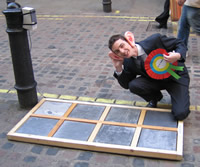 Living Streets, a national charity, launched its election campaign, “Talk to me about streets”, by making street items like paving and signs talk back to passers-by in Meard Street, Soho, London.
Living Streets, a national charity, launched its election campaign, “Talk to me about streets”, by making street items like paving and signs talk back to passers-by in Meard Street, Soho, London. Paving ‘squealed’ underfoot to point out the dangers of tripping over broken paving while spooky whispering windows resonated with the sound of absent children, no longer able to play in our dangerous streets.
Paving ‘squealed’ underfoot to point out the dangers of tripping over broken paving while spooky whispering windows resonated with the sound of absent children, no longer able to play in our dangerous streets.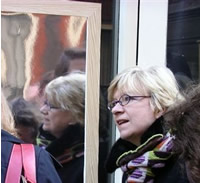 Living Streets Director Tom Franklin explains, “The streets are the one public service that everyone uses. Politicians can directly improve people’s daily lives by improving the street environment.”
Living Streets Director Tom Franklin explains, “The streets are the one public service that everyone uses. Politicians can directly improve people’s daily lives by improving the street environment.”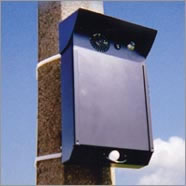 Verity Parker, who is doing an PhD at Brunel investigating electrical conductive fabrics, worked with Stock Displays to produce talking street signs, labelled in standard UK form, but with short audio samples.
Verity Parker, who is doing an PhD at Brunel investigating electrical conductive fabrics, worked with Stock Displays to produce talking street signs, labelled in standard UK form, but with short audio samples.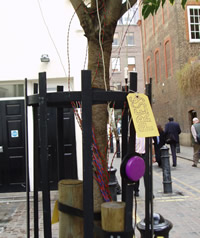 ‘The street that talks’ has the support of the Royal National Institute of the Blind, (RNIB) which also campaigns for streets and the built environment to be more accessible to blind and partially sighted people.
‘The street that talks’ has the support of the Royal National Institute of the Blind, (RNIB) which also campaigns for streets and the built environment to be more accessible to blind and partially sighted people. An accompanying new Living Streets’ pamphlet – written by two of Britain’s most eminent architects, Lord Richard Rogers and Sir Terry Farrell – was also unveiled at the event.
An accompanying new Living Streets’ pamphlet – written by two of Britain’s most eminent architects, Lord Richard Rogers and Sir Terry Farrell – was also unveiled at the event.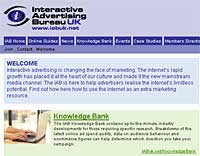 Cappuccino-supping Hoxtonites will be cheered by new figures showing that online advertising spending grew by a thumping 60% in 2004, edging ahead of radio in terms of market share for the first time.
Cappuccino-supping Hoxtonites will be cheered by new figures showing that online advertising spending grew by a thumping 60% in 2004, edging ahead of radio in terms of market share for the first time.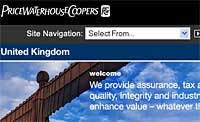 Online spending went against the overall general advertising trend, with total UK spend rising just 5.8% in 2004 to £16.9bn (US$31.7bn/€24.7bn) in 2004, based on figures from the Advertising Association and WARC.
Online spending went against the overall general advertising trend, with total UK spend rising just 5.8% in 2004 to £16.9bn (US$31.7bn/€24.7bn) in 2004, based on figures from the Advertising Association and WARC. Pace Micro Technology, a cutting edge UK digital set-top box provider tasked with developing emerging technologies across all television platforms, has trumpeted the launch of a number of STB’s and PVR’s, including the Laguna DC551HD and DC 501 Chicago all-digital set-top box.
Pace Micro Technology, a cutting edge UK digital set-top box provider tasked with developing emerging technologies across all television platforms, has trumpeted the launch of a number of STB’s and PVR’s, including the Laguna DC551HD and DC 501 Chicago all-digital set-top box. Pace is also offering the Tahoe DC775 HD-DVR, claiming it to be the most advanced high definition DVR for North America, and the first cable set-top box to offer features based on next generation silicon. Interestingly it offers a number of ways to save video content to the 160Gb hard drive – Standard Definition (SD), High Def (HD) and enhanced analogue. With multi-room video distribution and support for high-speed data connections for home computers, wireless routers and VoIP included you might be wondering what isn’t included.
Pace is also offering the Tahoe DC775 HD-DVR, claiming it to be the most advanced high definition DVR for North America, and the first cable set-top box to offer features based on next generation silicon. Interestingly it offers a number of ways to save video content to the 160Gb hard drive – Standard Definition (SD), High Def (HD) and enhanced analogue. With multi-room video distribution and support for high-speed data connections for home computers, wireless routers and VoIP included you might be wondering what isn’t included. Pace Americas’ VP of Technology Chris Dinallo had clearly feasted on a diet of buzzwords before adding, “All-digital and digital simulcast are critical industry initiatives, and uniquely, Pace is proud to be the only set-top box provider that can support all-digital on both networks.”
Pace Americas’ VP of Technology Chris Dinallo had clearly feasted on a diet of buzzwords before adding, “All-digital and digital simulcast are critical industry initiatives, and uniquely, Pace is proud to be the only set-top box provider that can support all-digital on both networks.”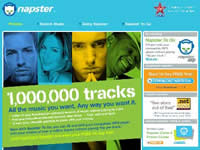 Napster UK has teamed up with Channel 4 to broadcast a short series of live TV music shows, creating the first national terrestrial television programme to be run by a digital music service.
Napster UK has teamed up with Channel 4 to broadcast a short series of live TV music shows, creating the first national terrestrial television programme to be run by a digital music service.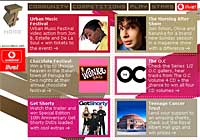 Building up to a crescendo of mutual backslapping, Sharman added: “Channel 4 has a deserved reputation for groundbreaking and forward-looking programming as well as championing live music, so we’re delighted to make our TV debut on their platform. Napster is also extremely fortunate to have a partner like Blaze TV whose production skills, expertise and contact book have proven invaluable in creating this series.”
Building up to a crescendo of mutual backslapping, Sharman added: “Channel 4 has a deserved reputation for groundbreaking and forward-looking programming as well as championing live music, so we’re delighted to make our TV debut on their platform. Napster is also extremely fortunate to have a partner like Blaze TV whose production skills, expertise and contact book have proven invaluable in creating this series.”